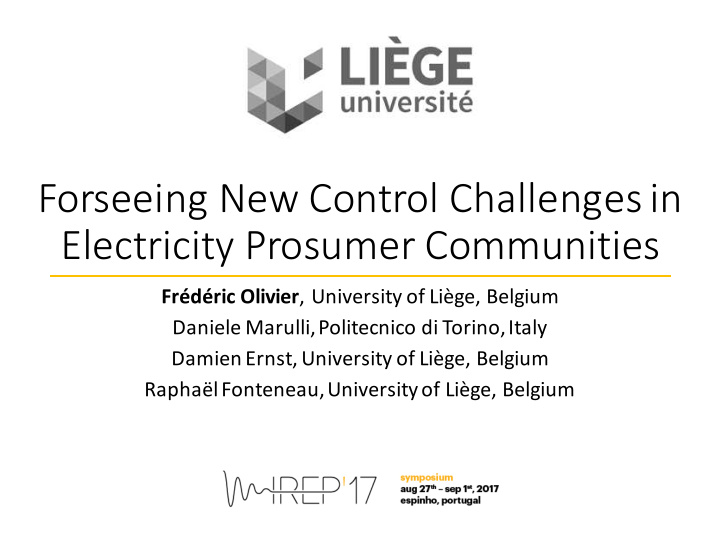



Forseeing New Control Challenges in Electricity Prosumer Communities Frédéric Olivier , University of Liège, Belgium Daniele Marulli, Politecnico di Torino, Italy Damien Ernst, University of Liège, Belgium Raphaël Fonteneau, Universityof Liège, Belgium
Introduction • Electricity Prosumer Community • Distributedgeneration • Storage • Information technologies • Objectives • Propose a rigorous mathematical framework for studying energy prosumer communities • Present a new class of interesting control problems and challenges, to increase the hosting capacity of LV networks. 2
Outline • The Electricity Prosumer Community • Formalisation • Control challenges • Centralized vs distributed schemes 3
The electricity prosumer community • Definition Electricity distribution system containing loads and distributed energy resources (such as distributed generators, storage devices, or controllable loads), that can be operated in a controlled, coordinated way 4
The electricity prosumer community • Similar to microgrids • Cannot operate in island mode • Comprises consumers cooperating for the satisfaction of their energy needs using local production sources 5
The electricity prosumer community • Drivers • With a shared infrastructure between the members • Without a shared infrastructure • Network operation • Energy market Communities extend the perimeter of self- consumption from one prosumer to several to pool production and flexibility means 6
Formalisation - The prosumer Production Active and reactive power production Storage Network Active power stored Active and Level of charge reactive power injected into the distribution Load network Active and reactive power consumption 7
Formalisation – The community • Power exchanges between prosumers • Losses equal to the differencebetween the houses and the root of the community 8
Formalisation • Cost and revenues for each prosumer • Price between each member of the community • Price for electricity from the distribution network • Community behaviour • Discrete time setting • For each time step, the variables change as a function of the previous states and exogeneousvariables, with some uncertainty 9
Control challenges • Decision making problems • Maximising the distributed production • And increase the network’s hosting capacity • And limit losses • Optimising overall costs and revenues • Minimise the total electricity bill of the community 10
Centralised vs distributed Requirements • Inverters that are controllable in active and reactive power • Controllable loads can be considered • Voltage et power measurements • Model of the network • No model • Extensive communication • No or little communication • Centralised computer/controller 11
Distributed schemes • Generating a data set using multiperiod OPF • Different load patterns, PV production profiles, prices • Learning regressorsusing Extremely Randomized Trees • Constraining the prediction • Simulating the behaviour of the agents Community electricity bill compared to a distributed rule of thumb Centralised (FBS-OPF) 19,6% Distributed (Rule of thumb) 100% Distributed (Extra trees) 47,3% 12
Conclusion • In the paper: • Mathematical framework for modellingElectricity Prosumer Communitiesand energy exchanges between prosumers • Introduction of a distributedapproach using machine learning • Future work: • Using reinforcementlearning for agent self- improvement 13
Recommend
More recommend